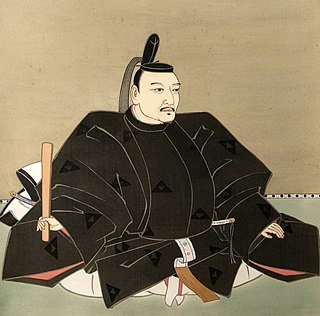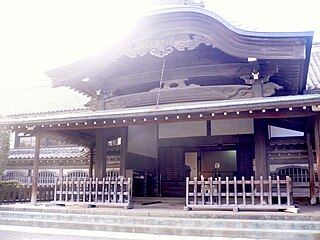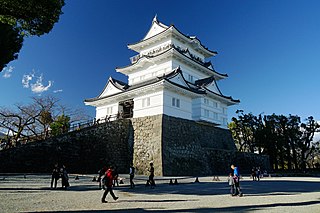 W
WEdo Castle , also known as Chiyoda Castle , is a flatland castle that was built in 1457 by Ōta Dōkan. It is today part of the Tokyo Imperial Palace and is in Chiyoda, Tokyo, Toshima District, Musashi Province. Tokugawa Ieyasu established the Tokugawa shogunate here. It was the residence of the shōgun and location of the shogunate, and also functioned as the military capital during the Edo period of Japanese history. After the resignation of the shōgun and the Meiji Restoration, it became the Tokyo Imperial Palace. Some moats, walls and ramparts of the castle survive to this day. However, the grounds were more extensive during the Edo period, with Tokyo Station and the Marunouchi section of the city lying within the outermost moat. It also encompassed Kitanomaru Park, the Nippon Budokan Hall and other landmarks of the surrounding area.
 W
WHachigata Castle was a Japanese castle, located in Yorii, Saitama Prefecture, Japan. The site was designated a National Historic Site.
 W
WHachiōji Castle is a yamashiro, or mountain-castle, located in Hachiōji, Tokyo, Japan.
 W
WHōjō Genan was a Japanese Samurai of the Sengoku period. He was the second and youngest son of Hōjō Sōun. Genan was a highly educated samurai, thus he worked as a diplomat of the Later Hōjō clan.
 W
WHōjō Sōun was the first head of the Later Hōjō clan, one of the major powers in Japan's Sengoku period. Born Ise Moritoki, he was originally known as Ise Shinkurō (新九郎), a samurai of Taira lineage from a reputable family of shogunate officials. Although he only belonged to a side branch of the main, more prestigious Ise family, he fought his way up, gaining territory and changing his name in imitation of the illustrious Hōjō.
 W
WHōjō Tsunashige also known as Hōjō Tsunanari was an officer of great skill under the Hōjō clan. The adopted brother of Hōjō Ujiyasu. Around the Kantō region, he fought in many battles supporting the Hōjō, also contributing to the expansion of the domain of Hōjō, he was well known for his fighting skill and also an excellent diplomat.
 W
WHōjō Ujimasa was the fourth head of the later Hōjō clan, and daimyō of Odawara. His childhood name was Matsuchiyo-maru (松千代丸). He was a son-in-law of Takeda Shingen.
 W
WHōjō Ujinao was a Japanese daimyō of the late Sengoku period, and the final head of the Later Hōjō clan. An important figure in the history of Azuchi-Momoyama politics, he lost his entire domain following the siege in 1590. Despite this, he survived, and his family carried on as small daimyo in the Edo period.
 W
WHōjō Ujiteru (1540? – August 10, 1590) was a Japanese samurai, who was the son of Hōjō Ujiyasu and lord of Hachiōji Castle in what is now Tokyo.
 W
WHōjō Ujitsuna was the son of Hōjō Sōun, founder of the Go-Hōjō clan. He continued his father's quest to gain control of the Kantō.
 W
WHōjō Ujiyasu was a daimyō (warlord) and third head of the Odawara Hōjō clan. Known as the "Lion of Sagami", he was revered as a fearsome warrior and a cunning man. He is famous for his strategies that defeated Shingen and Kenshin. The son of Hōjō Ujitsuna, his only known wife was Imagawa Yoshimoto's sister, Zuikei-in. Among his sons are Hōjō Ujimasa and Uesugi Kagetora.
 W
WIwatsuki Castle is a Japanese castle located in Iwatsuki-ku, Saitama, in Saitama Prefecture, Japan. At the end of the Edo period, Tateyama Castle was home to the Ōoka clan, daimyō of Iwatsuki Domain, however the castle dates from the Muromachi period and was inhabited by many samurai lords over its history. During the Edo period, the name of the castle was written as “岩付城”. It was also known as "White Crane Castle" or "Floating Castle" . The site of the castle is a Saitama Prefectural Historic Monument.
 W
WKakegawa Domain was a feudal domain under the Tokugawa shogunate of Edo period Japan. The domain was centered at Kakegawa Castle in Tōtōmi Province, in what is now the city of Kakegawa, Shizuoka.
 W
WKawagoe Castle is a flatland Japanese castle in the city of Kawagoe, in Japan's Saitama Prefecture. It is the closest castle to Tokyo to be accessible to visitors, as Edo castle is now the Imperial palace, and largely inaccessible.
 W
WKōkukuji Castle was a Sengoku period yamashiro-style Japanese castle located in what is now part of the city of Numazu, Shizuoka prefecture. The site has been protected by the central government as a National Historic Site since 1975.
 W
WKozukue Castle is the name for the earthly remains of a castle structure in Kozukue, Kōho-ku ward of Yokohama, Kanagawa Prefecture, Japan.
 W
WLady Hayakawa was a Japanese woman and aristocrat of the Sengoku period. Hayakawa is a common nickname for one of Daimyō Hōjō Ujiyasu's daughters, who lived in the Sengoku through early Edo periods. She is best known for marrying into the Imagawa clan as a condition for The Kōsōsun Triple Alliance, an alliance which put daughters of the Takeda, Imagawa and Hojo clans into political marriages. The formation of the alliance would later change the fate of these three powerful clans.
 W
WNagahama Castle was a Sengoku period flatland-style Japanese castle located in what is now part of the city of Numazu, Shizuoka prefecture. The site has been protected by the central government as a National Historic Site since 1988.
 W
WOdawara Castle is a landmark in the city of Odawara in Kanagawa Prefecture, Japan.
 W
WThe 1545–1546 Siege of Kawagoe Castle was part of a failed attempt by the Uesugi clan to regain Kawagoe Castle from the Later Hōjō clan in the Sengoku period of Japan.
 W
WTaki-no Castle is a flatland-hilltop Japanese castle ruin located in Tokorozawa, Saitama Prefecture. It was on a key route between the northern Kanto Plain and Hachioji.
 W
WTakiyama Castle is a castle structure in Hachiōji, Tokyo Prefecture, Japan. Takiyama Castle was built by Ōishi Sadashige in 1521. Hōjō Ujiteru expanded and improved the defence of the castle after he became lord.
 W
WTamanawa Castle was a castle structure in Tamanawa ward of Kamakura, Kanagawa Prefecture, Japan. The adopted brother of Hōjō Ujiyasu, Hōjō Tsunashige was command of the castle.
 W
WTokuhime was a princess during the Sengoku and Edo periods of Japanese history. She was the second daughter of Tokugawa Ieyasu; her mother was Lady Nishigori (西郡の方), one of Ieyasu's concubines. Tokuhime was also known as Ofū, Tomiko, Harima-gozen, and Ryōshō-in.
 W
WYamanaka Castle was a Sengoku period yamajiro-style Japanese castle, built by the Odawara Hōjō clan in Tagata District, Izu Province, in what is now eastern Mishima, Shizuoka Prefecture, Japan. The site has been protected by the central government as a National Historic Site since 1988.